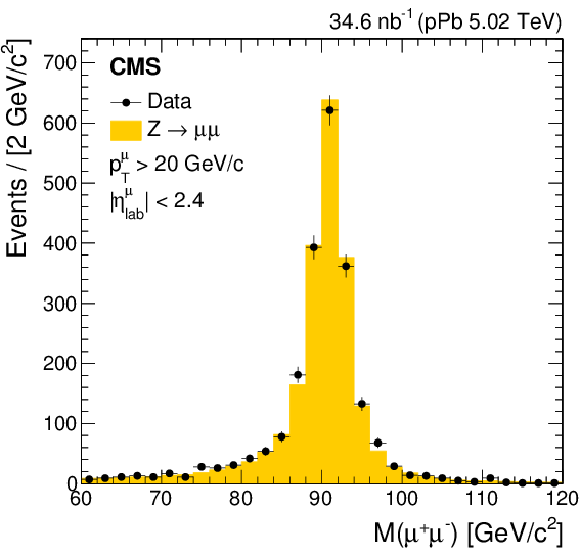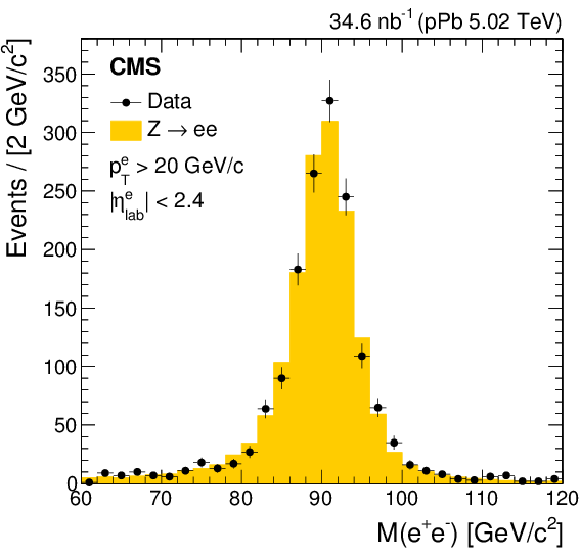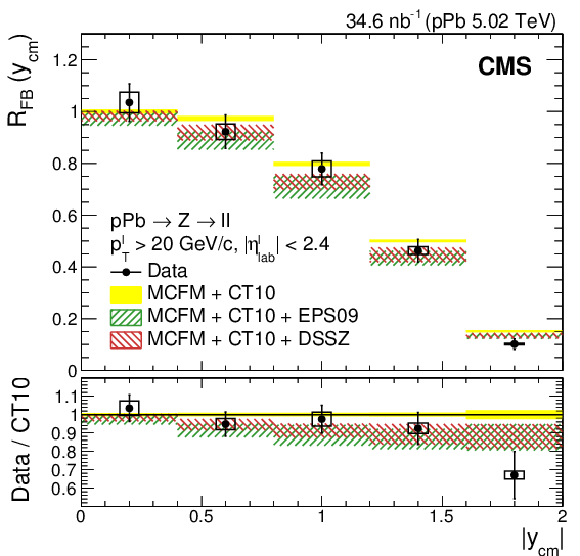

Compact Muon Solenoid
LHC, CERN
| CMS-HIN-15-002 ; CERN-PH-EP-2015-302 | ||
| Study of Z boson production in pPb collisions at $\sqrt{{s_{NN}}}= $ 5.02 TeV | ||
| CMS Collaboration | ||
| 20 December 2015 | ||
| Phys. Lett. B 759 (2016) 36 | ||
| Abstract: The production of Z bosons in pPb collisions at $\sqrt{s_\mathrm{NN}} = $ 5.02 TeV is studied by the CMS experiment via the electron and muon decay channels. The inclusive cross section is compared to pp collision predictions, and found to scale with the number of elementary nucleon-nucleon collisions. The differential cross sections as a function of the Z boson rapidity and transverse momentum are measured. Though they are found to be consistent within uncertainty with theoretical predictions both with and without nuclear effects, the forward-backward asymmetry suggests the presence of nuclear effects at large rapidities. These results provide new data for constraining nuclear parton distribution functions. | ||
| Links: e-print arXiv:1512.06461 [hep-ex] (PDF) ; CDS record ; inSPIRE record ; HepData record ; CADI line (restricted) ; | ||
| Figures | |

png pdf |
Figure 1-a:
Invariant mass of selected muon (a) and electron (b) pairs compared to PYTHIA 6+HIJING simulated $\mathrm { pN \to Z \to \ell \ell } $ events with $\mathrm { N = ( p , n ) } $ according to the number of nucleons in the Pb nucleus. The MC sample is normalized to the number of events in the data. |

png pdf |
Figure 1-b:
Invariant mass of selected muon (a) and electron (b) pairs compared to PYTHIA 6+HIJING simulated $\mathrm { pN \to Z \to \ell \ell } $ events with $\mathrm { N = ( p , n ) } $ according to the number of nucleons in the Pb nucleus. The MC sample is normalized to the number of events in the data. |

png pdf |
Figure 2:
Differential cross section of the Z bosons in pPb collisions as a function of rapidity in the fiducial region for the combined leptonic decay channel. Colored boxes are predictions from the MCFM generator, scaled by 208 (see text), and using nuclear (EPS09 and DSSZ) or free (CT10) PDF sets. The bottom panel shows the ratio of the data and the nPDF predictions to the CT10 PDF set. The vertical bars (boxes) represent the statistical (systematic) uncertainties. |

png pdf |
Figure 3:
Forward-backward asymmetry $R_\mathrm {FB}$ distribution of the Z bosons in pPb collisions as a function of rapidity in the fiducial region for the combined leptonic decay channel compared to the predictions from the MCFM generator with nuclear (EPS09 and DSSZ) or free (CT10) PDF sets. The bottom panel shows the ratio of the data and the nPDF predictions to the CT10 PDF set. The vertical bars (boxes) represent the statistical (systematic) uncertainties. |

png pdf |
Figure 4:
Differential cross section of the Z bosons in pPb collisions as a function of transverse momentum in the fiducial region for the combined leptonic decay channel compared to the prediction from the POWHEG+PYTHIA 6 generator scaled by the number of nucleons in the Pb nucleus. The vertical bars (boxes) represent the statistical (systematic) uncertainties. The 3.5% luminosity uncertainty is shown in the ratio plot as a hashed band together with the assumed 5% theoretical uncertainty, shown as a yellow band. |
| Tables | |

png pdf |
Table 1:
Summary of systematic uncertainties in the two decay channels. |

png pdf |
Table 2:
Results of the $\chi ^2$ test between the measurements and the theoretical predictions with and without nuclear modification from the EPS09 or DSSZ nPDF sets. The differential cross section and the forward-backward asymmetry have twelve and five numbers of degrees of freedom (NDF), respectively. |
| Summary |
| The cross section of Z boson production has been measured in the muon and electron decay channels in pPb collisions at $\sqrt{s_\mathrm{NN}} =$ 5.02 TeV. The NLO pp inclusive cross section from POWHEG+PYTHIA-6 scaled by the number of elementary nucleon-nucleon collisions is in agreement with the measured pPb cross section. The pPb theoretical predictions for the differential cross section as a function of Z boson rapidity with and without nuclear effects are consistent with the measurement. At large rapidity, the forward-backward asymmetry deviates from predictions assuming free proton PDFs by an amount which is compatible with both the EPS09 and the DSSZ nPDF modifications, although the statistical precision of the measurement precludes making a definitive statement. The differential cross section as a function of the Z boson transverse momentum has been measured and is found to be in agreement with pp predictions from collisions at $\sqrt{s_\mathrm{NN}} =$ 5.02 TeV. The NLO pp inclusive cross section from , except at very low transverse momentum, where similar deviations as previously seen in pp are observed. The presented results provide new data for constraining nuclear PDF fits. |

|
Compact Muon Solenoid LHC, CERN |

|

|

|

|

|

|